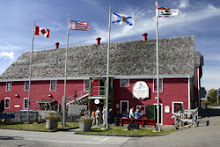Researchers have long known the benefits of reading through old issues of newspapers and periodicals for information about historical subjects. Items that were once "everyday news" help to back up primary research in a variety of topics. Whether your interest is genealogy, local history or other, more specific subjects, the publications from days of yore are bound to have interesting tidbits of information.
It isn’t necessary to have access to the actual newspapers or magazines. Microfilmed or digital copies of publications are often available for reading in museums, libraries and other research centres. They can sometimes be requested through inter-library loan. Of course, nothing truly compares with the sensation of reading original documents. One of my most thrilling research moments, when in university, came with the opportunity to read bound copies of original issues of "The Gentleman’s Magazine", which was first published in 1731, in London. Contrary to the implications of the title, it was a periodical that had a variety of articles, none of which were of a dubious nature. My quest for information had to do with an early archaelogical dig of Henry VIII’s castle of Nonsuch. Reading about the castle ruins, in dated language, helped to put me "right there" and I loved it.
This leads, however, to one of the perils of archival research. Unless you are particularly gifted with a strong sense of focus, your eyes will stray to interesting bits of news that have nothing to do with the topic at hand. Sometimes the curiosities of the day will strike a responsive chord; the best advice is to bring plenty of paper, or make a special file in your computer, to record snippets too good to be missed.
Two such instances were found during the course of other research:
From the "Digby Weekly Courier" - February 2, 1906
Fish Story: Smelt Swallows Bottle Contains PEI Man’s Note
New York, Jan. 31. While cleaning a large bloater smelt that came in a consignment of fish from New York this morning, Fred Ivamy of West Second Street found in the fish’s stomach a bottle about the size of a man’s thumb. It was securely corked and contained the following message written on a small piece of paper. "Whosoever gets this note will confer a favour by replying to undersigned. Harry Durant, Margate, Prince Edward Island, Canada, January 4, 1906."
The bottle holding it was stamped with the firm name of the T. Eaton Company Ltd. Toronto and though almost as large as the smelt’s mouth could easily have been swallowed by it.
From the Lunenburg "Progress-Enterprise"
September 29, 1909
One day last week while D. V. Richard, of West LaHave Ferry was fishing about seven miles off Indian Island, he captured a seven foot shark. When the shark was opened he found a French briar pipe half full of shag tobacco. What an awful thing the tobacco habit must be when even the fish of the sea cannot keep clear of it, or is it possible the tobacco trust is looking for a new market?








 Hello Everyone,
Hello Everyone,





